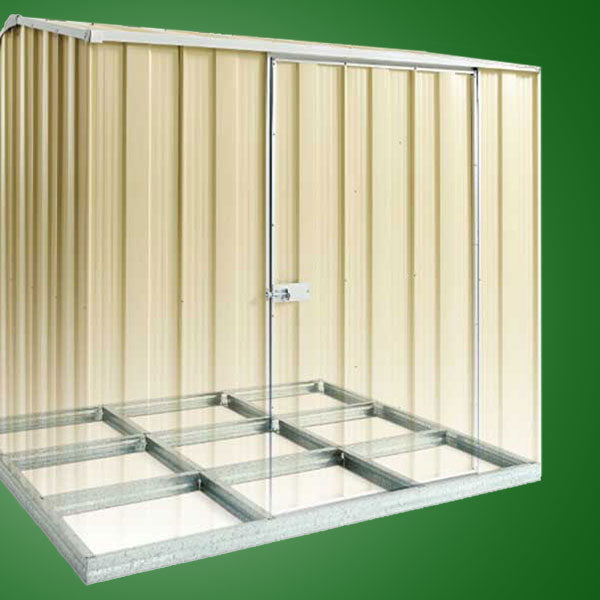You want your shed to be secure and last a long time, so let’s talk about the foundations. A shed base levels the ground to enable air circulation and supports the weight of your shed and also provides anchorage for your shed
When erecting a shed, there’s a few facts to consider:
- The ground needs to be prepared for a base to provide a consistent level base that doesn’t change due to weather conditions.
- Your base will need to be slightly elevated above ground to allow rainwater runoff and prevent water damage.
- The integrity of the shed structure will be impacted if it’s sitting too close or directly on the surface of soil and grass because during wet weather conditions, it will slope and slant.
Main materials for a shed base
There are three main materials for a garden shed floor that vary in terms of price, time frame and quality.
- Concrete slab
- Timber base
- Paver tiles
Here’s how to choose which option is best for your backyard.
Benefits of a Concrete Slab
A well-constructed concrete base is the most durable and can withstand exposure to the elements with minimal maintenance cost. If you plan to leave your shed in a permanent location in your yard, this is the best choice. You’ll rest assured that your valuables are secure due to the wind and water resistance the shed flooring provides.
The garden shed must be erected on a solid, level and foundation. We strongly recommend you to pour a concrete slab 75mm thick, reinforced with SL62 mesh (minimum)
Find an optimal location on your property: Figure out the natural watercourse of your property and avoid places where water tends to build up, so the build site has natural drainage.Choose a slab type suited to weather conditions: A raised rebated concrete slab that’s at least 15cm above the surrounding ground is a good height to prevent water entry and damage to the shed’s contents.
After your shed’s been installed and you’re ready to leave your tools inside, consider investing in concrete fixings to guarantee the stability of your shed structure! Our shed come with anchor fixings
Concrete slabs are ideal for providing a safe and solid space to work from, and with concrete fixings, the shed will be properly anchored into the ground.
Timber Base
Is your garden a work in progress? If you’re searching for a shed base that offers the versatility of being able to be moved around while safely securing your outdoor storage, timber is the solution.
This is a better foundation for a lightweight shed and is more affordable to build than a concrete base. With the addition of a subfloor, timber flooring can be used for sites that are uneven or sloping.
Similar to concrete slabs, you can build a raised timber base to protect your shed from long term exposure to the elements.
What do I need to know before building a timber base?
We recommend using pressure-treated hardwood or timber because it has undergone a specialised chemical treatment that increases the wood’s longevity by making it resistant to moisture, mould, rot, fungi and insect attack.
Once levelled, they provide a strong base for the shed while facilitating airflow, making a huge difference to your shed’s lifespan.
Benefits of Paver Tiles
This is an affordable and handy solution to building a shed base. A paver shed base is made from paving blocks. You can find them in a range of materials including concrete and brick. The tiles fit together tightly, creating a sturdy base for the shed.
If you’re looking into this shed base option, keep in mind that you’ll need to install large pavers to strengthen your shed foundation. They need to have some weight and be strong enough to enable concrete anchors to be drilled in.
How do I build a paver tile base for my shed?
- Prepare the area by digging out dirt and removing any ground material.
- Determine the depth required to install the gravel, sand and pavers.
- Spread the gravel evenly into the area.
- Add a layer of sand with a shovel and level it with a straight piece of timber.
- Use a ruler to check that the floor level is elevated above ground.
- Set the pavers and add a concrete seal.
The uncomplicated nature of this method makes it popular for people who would like to erect their shed quickly without compromising the lifespan of their outdoor storage unit.
Is there anything else I should consider before building my shed base?
- Be mindful of local council regulations and check what you can do with someone first.
- Prevent future flooding by installing your shed in an appropriate area, avoid any low-lying areas or any sloped areas prone to wet weather exposure.
- Consider the convenience and accessibility of your shed on your property.
- Aim to install your shed in a sunny, well-lit location to prevent exposure to mould growth and allergens.
- Consider if there is any impact on your neighbours – they may not want to look at the back of your shed!

